engine oil YAMAHA PW50 2016 Owners Manual
[x] Cancel search | Manufacturer: YAMAHA, Model Year: 2016, Model line: PW50, Model: YAMAHA PW50 2016Pages: 80, PDF Size: 1.84 MB
Page 8 of 80

Table of contents
Location of important la bels ........... 1-1
Safety information ............................ 2-1
Description ....................................... 3-1
Left view ......................................... 3-1
Right view ....................................... 3-2
Controls and instruments ............... 3-3
Instrument an d control functions ... 4-1
Handlebar switch............................ 4-1
Speed limiter and power reduction
plate ............................................ 4-1
Front brake lever ............................ 4-2
Rear brake lever ............................. 4-3
Fuel tank cap .................................. 4-3
Fuel ................................................. 4-4
Fuel tank breather hose.................. 4-6
2-stroke engine oil .......................... 4-6
Fuel cock ........................................ 4-7
Starter (choke) lever ...................... 4-7
Kickstarter ...................................... 4-8
Seat ................................................ 4-8
Cable lock (for Europe) ................... 4-9
For your safety – pre-operation
checks ............................................... 5-1
Operation an d important ri din g
points ................................................ 6-1
Starting and warming up a cold engine ......................................... 6-1
Starting a warm engine .................. 6-2
Starting off ...................................... 6-2
Acceleration and deceleration ........ 6-3
Braking ........................................... 6-3
Engine break-in .............................. 6-4
Parking ........................................... 6-4
Perio dic maintenance an d
a d justment ........................................ 7-1
Owner’s tool kit .............................. 7-2
Periodic maintenance chart for the emission control system ............. 7-3
General maintenance and
lubrication chart .......................... 7-4 Checking the spark plug ................. 7-6
Removing the power reduction
plate ............................................. 7-7
Transmission oil .............................. 7-8
Middle and final gear cases ............ 7-9
Cleaning the air filter element ....... 7-10
Cleaning the spark arrester ........... 7-11
Adjusting the carburetor ............... 7-12
Adjusting the engine idling speed ......................................... 7-12
Checking the throttle grip free
play ............................................ 7-13
Tires .............................................. 7-14
Panel wheels ................................. 7-16
Adjusting the front and rear brake lever free play ............................ 7-16
Checking the front and rear brake
shoes ......................................... 7-17
Checking and lubricating the cables ........................................ 7-18
Checking and lubricating the throttle grip and cable ............... 7-19
Adjusting the Autolube pump ....... 7-19
Lubricating the front and rear
brake levers ............................... 7-20
Checking and lubricating the
centerstand ................................ 7-20
Checking the front fork ................. 7-21
Checking the steering ................... 7-21
Checking the wheel bearings ........ 7-22
Front wheel ................................... 7-22
Rear wheel .................................... 7-24
Troubleshooting ............................ 7-26
Troubleshooting chart ................... 7-27
Motorcycle care an d stora ge .......... 8-1
Matte color caution ......................... 8-1
Care................................................. 8-1
Storage............................................ 8-3
Specifications ................................... 9-1
Consumer information ................... 10-1
Identification numbers .................. 10-1
In dex .
............................................... 11-1
U2SA82E0.book Page 1 Monday, June 8, 2015 1:09 PM
Page 24 of 80
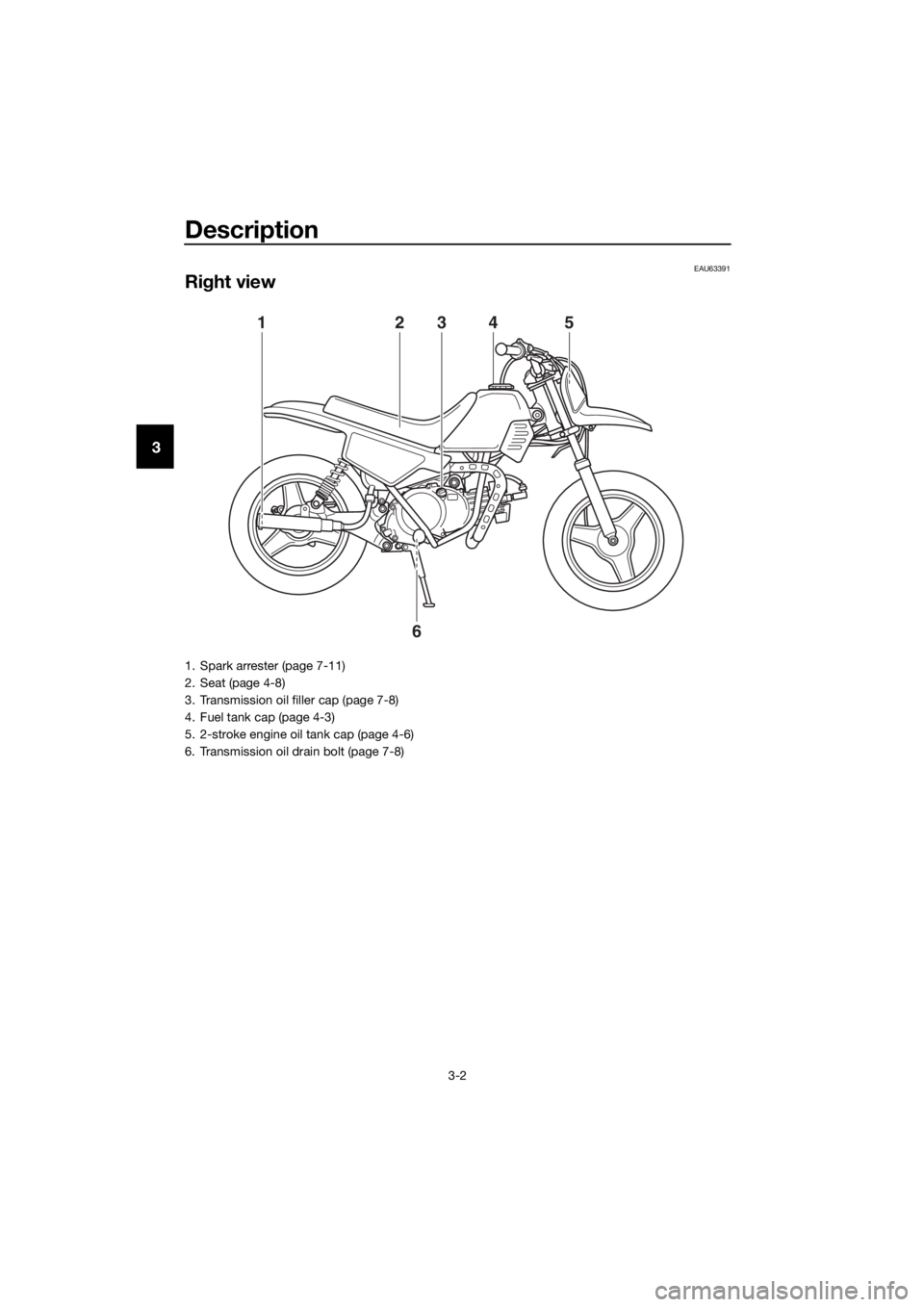
Description
3-2
3
EAU63391
Right view
12345
6
1. Spark arrester (page 7-11)
2. Seat (page 4-8)
3. Transmission oil filler cap (page 7-8)
4. Fuel tank cap (page 4-3)
5. 2-stroke engine oil tank cap (page 4-6)
6. Transmission oil drain bolt (page 7-8)
U2SA82E0.book Page 2 Monday, June 8, 2015 1:09 PM
Page 31 of 80
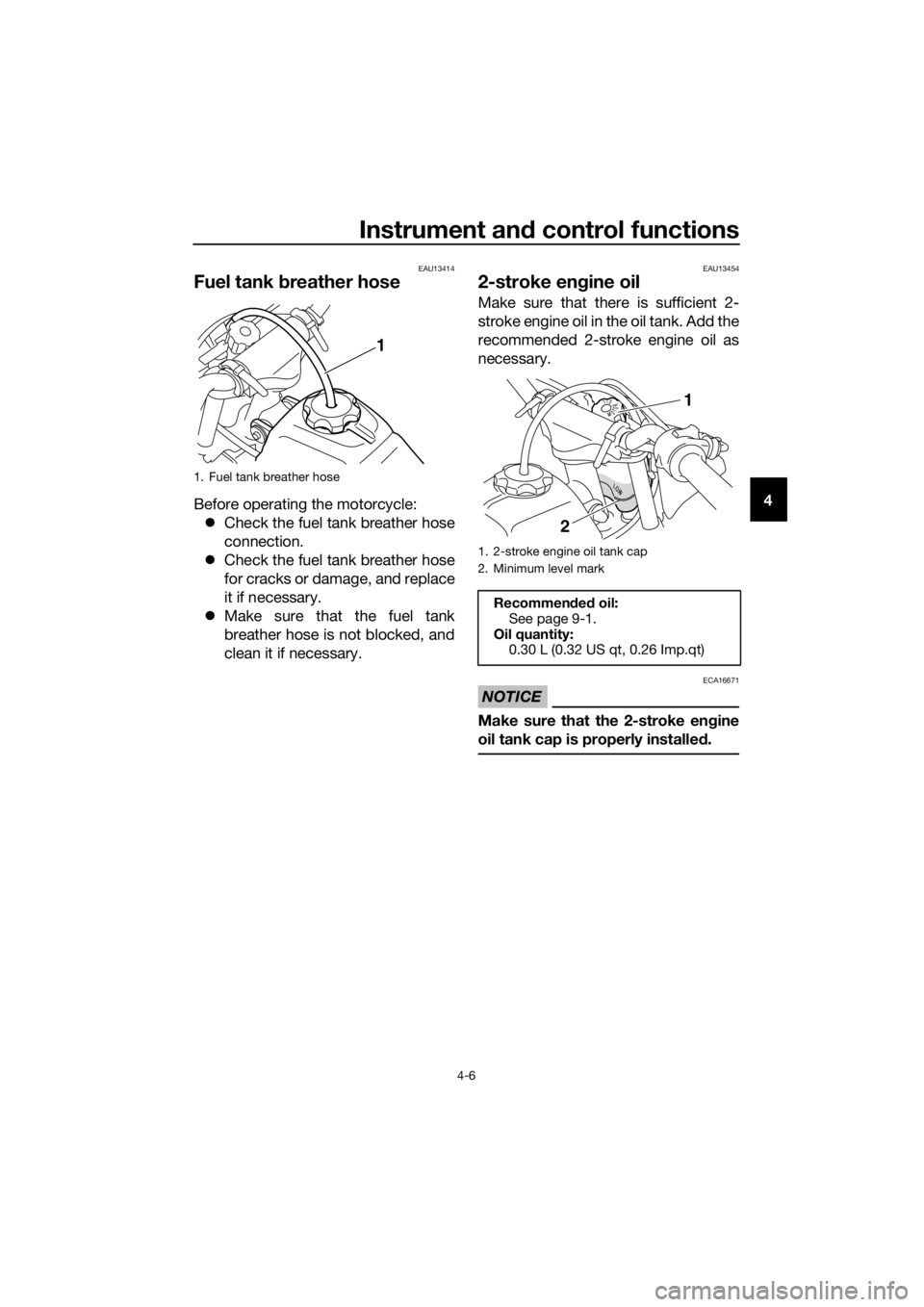
Instrument and control functions
4-6
4
EAU13414
Fuel tank breather hose
Before operating the motorcycle:
Check the fuel tank breather hose
connection.
Check the fuel tank breather hose
for cracks or damage, and replace
it if necessary.
Make sure that the fuel tank
breather hose is not blocked, and
clean it if necessary.
EAU13454
2-stroke en gine oil
Make sure that there is sufficient 2-
stroke engine oil in the oil tank. Add the
recommended 2-stroke engine oil as
necessary.
NOTICE
ECA16671
Make sure that the 2-stroke en gine
oil tank cap is properly installe d.
1. Fuel tank breather hose
1
1. 2-stroke engine oil tank cap
2. Minimum level mark
Recommen ded oil:
See page 9-1.
Oil quantity: 0.30 L (0.32 US qt, 0.26 Imp.qt)
2 1
U2SA82E0.book Page 6 Monday, June 8, 2015 1:09 PM
Page 41 of 80
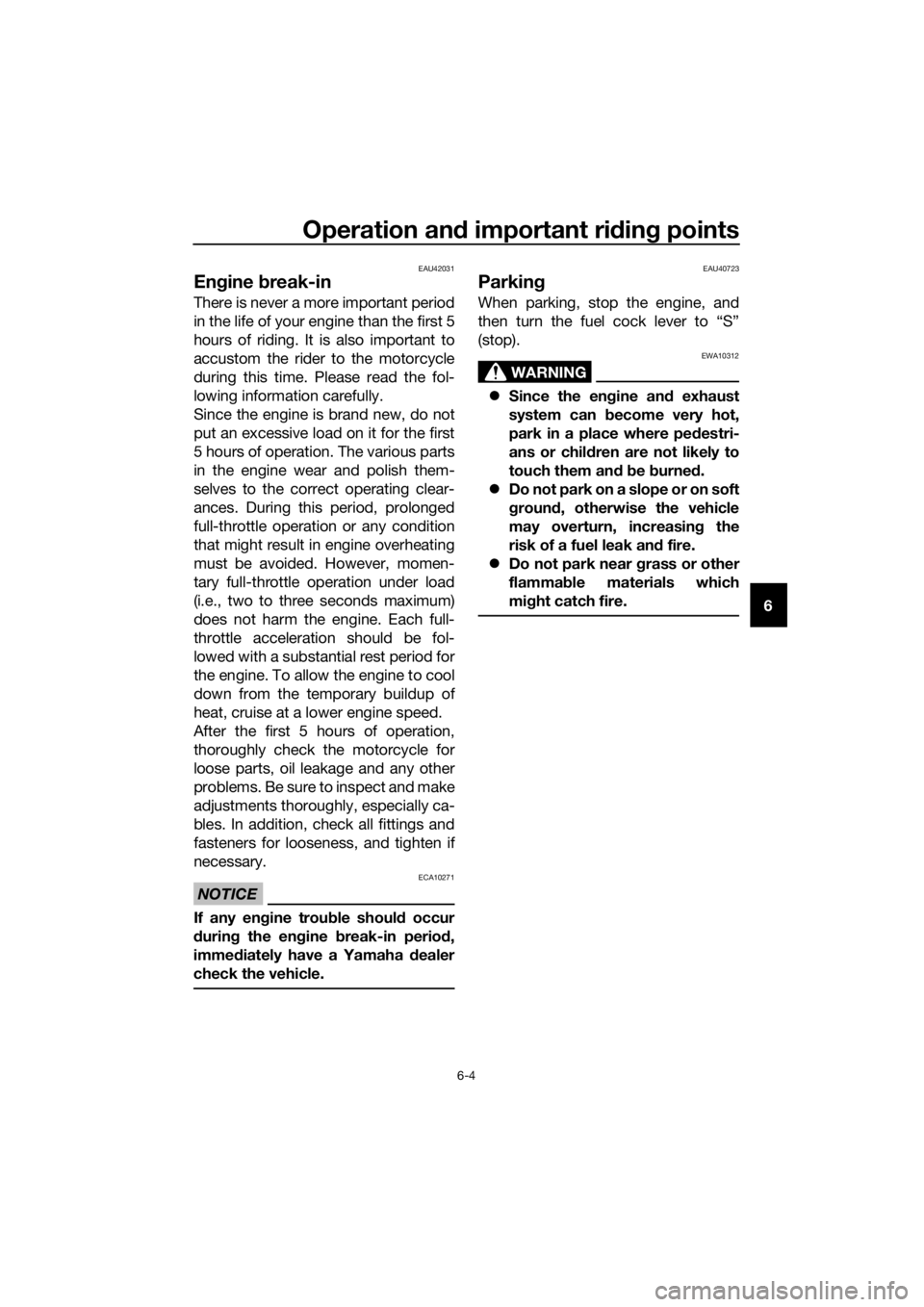
Operation and important ri din g points
6-4
6
EAU42031
En gine break-in
There is never a more important period
in the life of your engine than the first 5
hours of riding. It is also important to
accustom the rider to the motorcycle
during this time. Please read the fol-
lowing information carefully.
Since the engine is brand new, do not
put an excessive load on it for the first
5 hours of operation. The various parts
in the engine wear and polish them-
selves to the correct operating clear-
ances. During this period, prolonged
full-throttle operation or any condition
that might result in engine overheating
must be avoided. However, momen-
tary full-throttle operation under load
(i.e., two to three seconds maximum)
does not harm the engine. Each full-
throttle acceleration should be fol-
lowed with a substantial rest period for
the engine. To allow the engine to cool
down from the temporary buildup of
heat, cruise at a lower engine speed.
After the first 5 hours of operation,
thoroughly check the motorcycle for
loose parts, oil leakage and any other
problems. Be sure to inspect and make
adjustments thoroughly, especially ca-
bles. In addition, check all fittings and
fasteners for looseness, and tighten if
necessary.
NOTICE
ECA10271
If any en gine trou ble shoul d occur
d uring the en gine break-in perio d,
imme diately have a Yamaha d ealer
check the vehicle.
EAU40723
Parkin g
When parking, stop the engine, and
then turn the fuel cock lever to “S”
(stop).
WARNING
EWA10312
Since the en gine an d exhaust
system can become very hot,
park in a place where ped estri-
ans or chil dren are not likely to
touch them and b e burne d.
Do not park on a slope or on soft
groun d, otherwise the vehicle
may overturn, increasin g the
risk of a fuel leak an d fire.
Do not park near grass or other
flammab le materials which
mi ght catch fire.
U2SA82E0.book Page 4 Monday, June 8, 2015 1:09 PM
Page 49 of 80
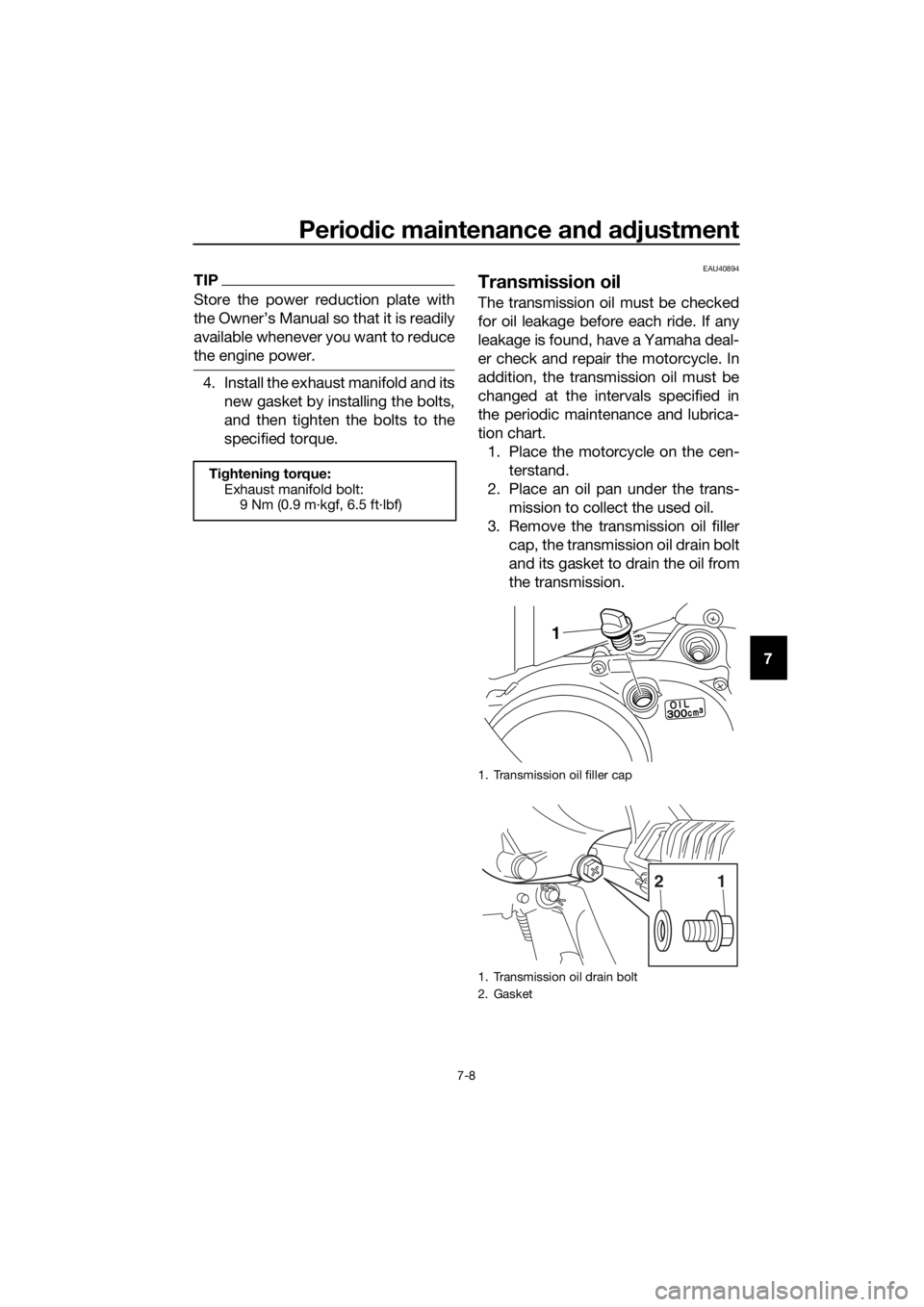
Periodic maintenance an d a djustment
7-8
7
TIP
Store the power reduction plate with
the Owner’s Manual so that it is readily
available whenever you want to reduce
the engine power.
4. Install the exhaust manifold and its
new gasket by installing the bolts,
and then tighten the bolts to the
specified torque.
EAU40894
Transmission oil
The transmission oil must be checked
for oil leakage before each ride. If any
leakage is found, have a Yamaha deal-
er check and repair the motorcycle. In
addition, the transmission oil must be
changed at the intervals specified in
the periodic maintenance and lubrica-
tion chart.1. Place the motorcycle on the cen- terstand.
2. Place an oil pan under the trans- mission to collect the used oil.
3. Remove the transmission oil filler cap, the transmission oil drain bolt
and its gasket to drain the oil from
the transmission.
Tightening torque:
Exhaust manifold bolt: 9 Nm (0.9 m·kgf, 6.5 ft·lbf)
1. Transmission oil filler cap
1. Transmission oil drain bolt
2. Gasket
1
12
U2SA82E0.book Page 8 Monday, June 8, 2015 1:09 PM
Page 50 of 80
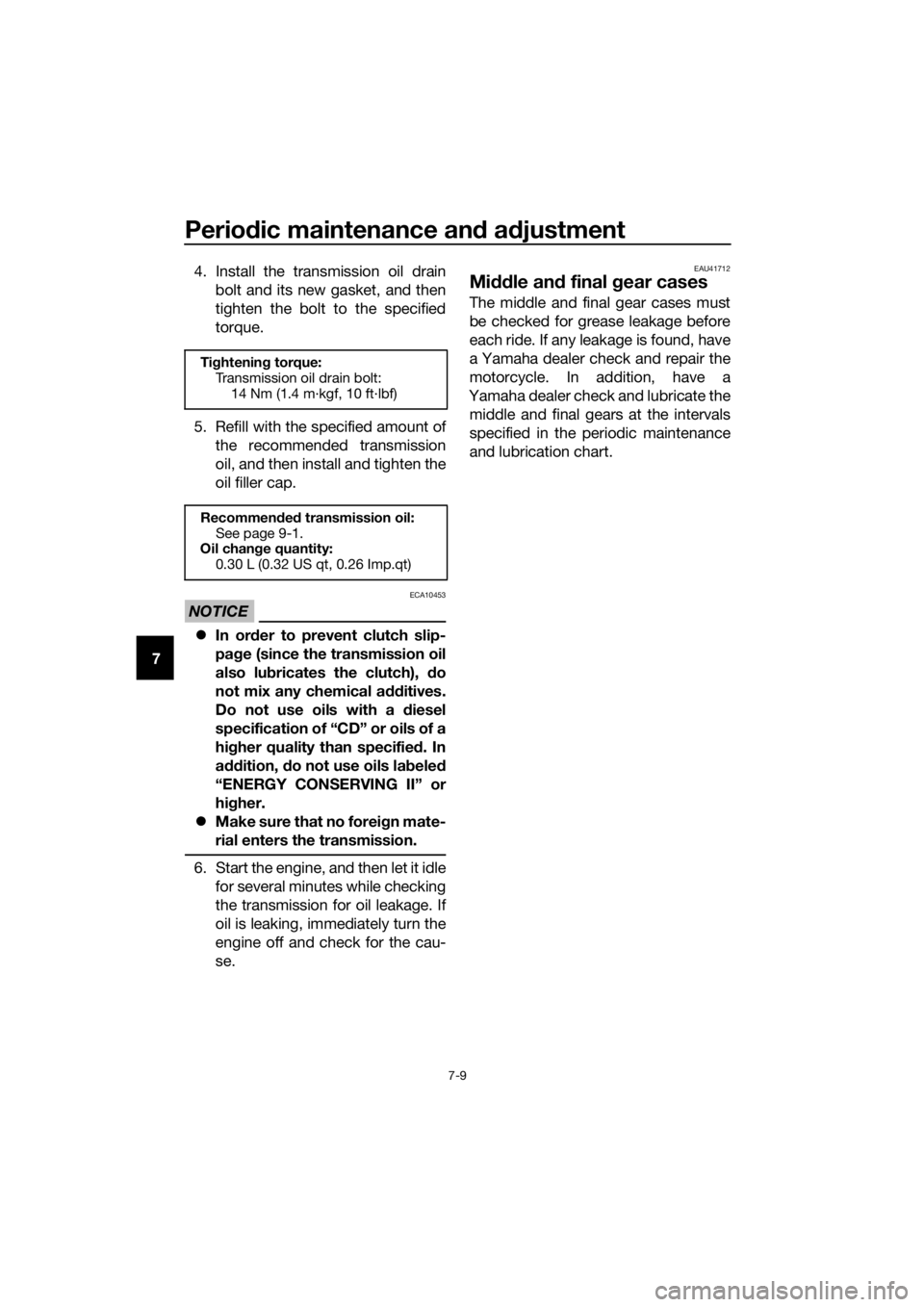
Periodic maintenance an d a djustment
7-9
7 4. Install the transmission oil drain
bolt and its new gasket, and then
tighten the bolt to the specified
torque.
5. Refill with the specified amount of the recommended transmission
oil, and then install and tighten the
oil filler cap.
NOTICE
ECA10453
In or der to prevent clutch slip-
pa ge (since the transmission oil
also lu bricates the clutch), d o
not mix any chemical additives.
Do not use oils with a diesel
specification of “CD” or oils of a
hi gher quality than specifie d. In
a ddition, do not use oils la bele d
“ENERGY CONSERVING II” or
hi gher.
Make sure that no forei gn mate-
rial enters the transmission.
6. Start the engine, and then let it idle for several minutes while checking
the transmission for oil leakage. If
oil is leaking, immediately turn the
engine off and check for the cau-
se.
EAU41712
Middle an d final g ear cases
The middle and final gear cases must
be checked for grease leakage before
each ride. If any leakage is found, have
a Yamaha dealer check and repair the
motorcycle. In addition, have a
Yamaha dealer check and lubricate the middle and final gears at the intervals
specified in the periodic maintenance
and lubrication chart.
Ti ghtenin g torque:
Transmission oil drain bolt: 14 Nm (1.4 m·kgf, 10 ft·lbf)
Recommen ded transmission oil:
See page 9-1.
Oil chan ge quantity:
0.30 L (0.32 US qt, 0.26 Imp.qt)
U2SA82E0.book Page 9 Monday, June 8, 2015 1:09 PM
Page 69 of 80
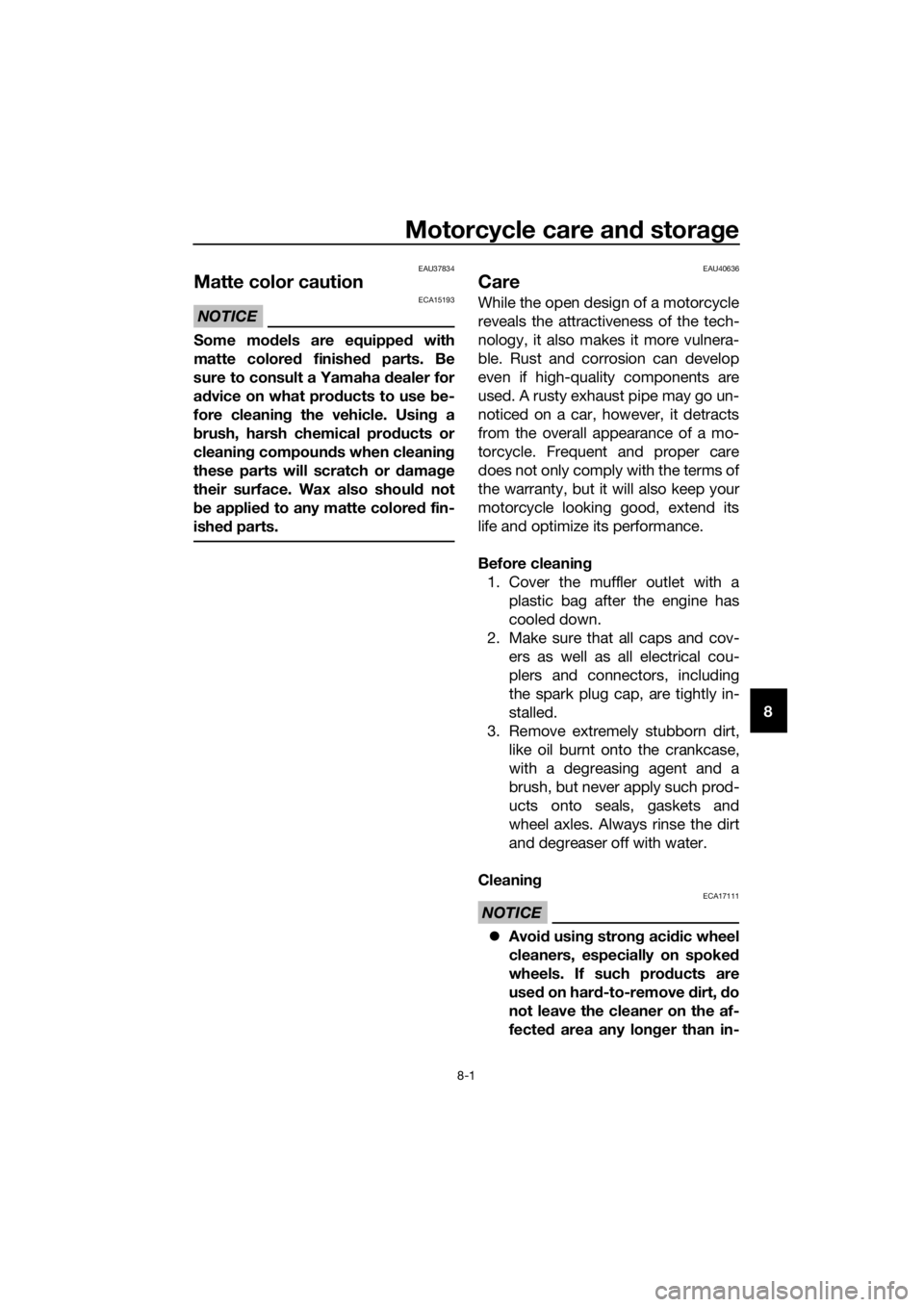
Motorcycle care and stora ge
8-1
8
EAU37834
Matte color caution
NOTICE
ECA15193
Some mo dels are equipped with
matte colored finished parts. Be
sure to consult a Yamaha dealer for
a d vice on what pro ducts to use be-
fore cleanin g the vehicle. Usin g a
b rush, harsh chemical prod ucts or
cleanin g compoun ds when cleanin g
these parts will scratch or damag e
their surface. Wax also shoul d not
b e applie d to any matte colored fin-
ishe d parts.
EAU40636
Care
While the open design of a motorcycle
reveals the attractiveness of the tech-
nology, it also makes it more vulnera-
ble. Rust and corrosion can develop
even if high-quality components are
used. A rusty exhaust pipe may go un-
noticed on a car, however, it detracts
from the overall appearance of a mo-
torcycle. Frequent and proper care
does not only comply with the terms of
the warranty, but it will also keep your
motorcycle looking good, extend its
life and optimize its performance.
Before cleanin g
1. Cover the muffler outlet with a plastic bag after the engine has
cooled down.
2. Make sure that all caps and cov- ers as well as all electrical cou-
plers and connectors, including
the spark plug cap, are tightly in-
stalled.
3. Remove extremely stubborn dirt, like oil burnt onto the crankcase,
with a degreasing agent and a
brush, but never apply such prod-
ucts onto seals, gaskets and
wheel axles. Always rinse the dirt
and degreaser off with water.
Cleanin g
NOTICE
ECA17111
Avoi d using strong aci dic wheel
cleaners, especially on spoked
wheels. If such pro ducts are
use d on har d-to-remove dirt, do
not leave the cleaner on the af-
fected area any lon ger than in-
U2SA82E0.book Page 1 Monday, June 8, 2015 1:09 PM
Page 70 of 80

Motorcycle care and stora ge
8-2
8 structe
d. Also, thorou ghly rinse
the area off with water, imme di-
ately dry it, an d then apply a cor-
rosion protection spray.
Improper cleanin g can d amage
plastic parts (such as cowlin gs,
panels, etc.) an d the mufflers.
Use only a soft, clean cloth or
spon ge with water to clean
plastic. However, if the plastic
parts cannot be thorou ghly
cleaned with water, dilute d mil d
d eter gent with water may b e
use d. Be sure to rinse off any
d eter gent resi due using plenty
of water, as it is harmful to plas-
tic parts.
Do not use any harsh chemical
prod ucts on plastic parts. Be
sure to avoi d using cloths or
spon ges which have been in
contact with stron g or a brasive
cleanin g prod ucts, solvent or
thinner, fuel (g asoline), rust re-
movers or inhi bitors, brake flui d,
antifreeze or electrolyte.
Do not use hi
gh-pr
essure wash-
ers or steam-jet cleaners since
they cause water seepa ge an d
d eterioration in the followin g ar-
eas: seals (of wheel an d swin g-
arm bearin gs, fork an d b rakes),
electric components (couplers,
connectors, an d switches),
b reather hoses an d vents.
After normal use
Remove dirt with warm water, a mild
detergent, and a soft, clean sponge,
and then rinse thoroughly with clean
water. Use a toothbrush or bottlebrush
for hard-to-reach areas. Stubborn dirt and insects will come off more easily if
the area is covered with a wet cloth for
a few minutes before cleaning.
After riding in the rain or near the sea
Since sea salt is extremely corrosive,
carry out the following steps after each
ride in the rain or near the sea.
1. Clean the motorcycle with cold water and a mild detergent, after
the engine has cooled down.
NOTICE: Do not use warm wa-
ter since it increases the corro-
sive action of the salt.
[ECA10792]
2. Apply a corrosion protection spray on all metal, including chrome-
and nickel-plated, surfaces to pre-
vent corrosion.
After cleaning 1. Dry the motorcycle with a chamois or an absorbing cloth.
2. Use a chrome polish to shine chrome, aluminum and stainless-
steel parts.
3. To prevent corrosion, it is recom- mended to apply a corrosion pro-
tection spray on all metal,
including chrome- and nickel-plat-
ed, surfaces.
4. Use spray oil as a universal clean- er to remove any remaining dirt.
5. Touch up minor paint damage caused by stones, etc.
6. Wax all painted surfaces.
7. Let the motorcycle dry completely before storing or covering it.
WARNING
EWA14502
Contaminants on the brakes or tires
can cause loss of control.
U2SA82E0.book Page 2 Monday, June 8, 2015 1:09 PM
Page 71 of 80

Motorcycle care and stora ge
8-3
8
Make sure that there is no oil or
wax on the tires.
If necessary, wash the tires with
warm water an d a mil d d eter-
g ent. Before ri din g at hi gher
speed s, test the motorcycle’s
b rakin g performance an d cor-
nering b ehavior.
NOTICE
ECA10801
Apply spray oil an d wax spar-
in gly an d make sure to wipe off
any excess.
Never apply oil or wax to any
rubber an d plastic parts, but
treat them with a suitab le care
prod uct.
Avoi d using abrasive polishin g
compoun ds as they will wear
away the paint.
TIP
Consult a Yamaha dealer for advice on
what products to use.
EAU40646
Stora ge
Short-term
Always store your motorcycle in a cool,
dry place and, if necessary, protect it
against dust with a porous cover. Be
sure the engine and the exhaust sys-
tem are cool before covering the mo-
torcycle.
NOTICE
ECA10811
Storin g the motorcycle in a
poorly ventilate d room or cover-
in g it with a tarp, while it is still
wet, will allow water an d humi d-
ity to seep in an d cause rust.
To prevent corrosion, avoi d
d amp cellars, sta bles (b ecause
of the presence of ammonia)
an d areas where stron g chemi-
cals are stored .
Long-term
Before storing your motorcycle for sev-
eral months: 1. Follow all the instructions in the “Care” section of this chapter.
2. For motorcycles equipped with a fuel cock that has an “S” (stop)
position: Turn the fuel cock lever
to “S”.
3. Drain the carburetor float chamber by loosening the drain bolt; this
will prevent fuel deposits from
building up. Pour the drained fuel
into the fuel tank.
4. Fill up the fuel tank and add fuel stabilizer (if available) to prevent
the fuel tank from rusting and the
fuel from deteriorating.
U2SA82E0.book Page 3 Monday, June 8, 2015 1:09 PM
Page 72 of 80

Motorcycle care and stora ge
8-4
8 5. Perform the following steps to
protect the cylinder, piston rings,
etc. from corrosion.a. Remove the spark plug cap and spark plug.
b. Pour a teaspoonful of engine oil into the spark plug bore.
c. Install the spark plug cap onto the spark plug, and then place
the spark plug on the cylinder
head so that the electrodes are
grounded. (This will limit spark-
ing during the next step.)
d. Turn the engine over several times with the starter. (This will
coat the cylinder wall with oil.)
e. Remove the spark plug cap from the spark plug, and then
install the spark plug and the
spark plug cap. WARNING! To
prevent damag e or injury
from sparkin g, make sure to
g roun d the spark plu g elec-
tro des while turnin g the en-
g ine over. [EWA10952]
6. Lubricate all control cables and
the pivoting points of all levers as
well as of the centerstand.
7. Check and, if necessary, correct the tire air pressure, and then lift
the motorcycle so that both of its
wheels are off the ground. Alterna-
tively, turn the wheels a little every
month in order to prevent the tires
from becoming degraded in one
spot.
8. Cover the muffler outlet with a plastic bag to prevent moisture
from entering it.
TIP
Make any necessary repairs before
storing the motorcycle.
U2SA82E0.book Page 4 Monday, June 8, 2015 1:09 PM